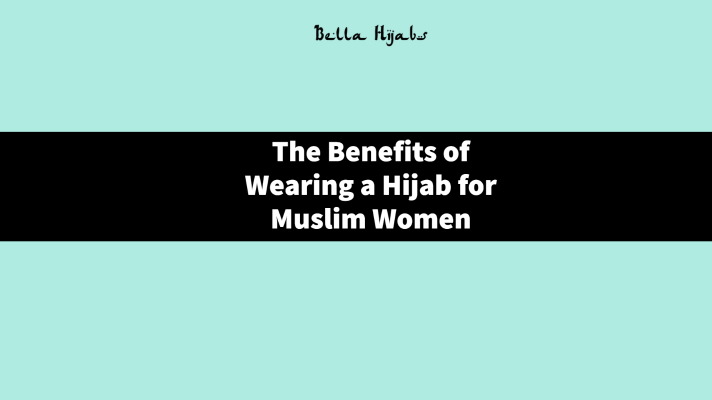
The hijab is a headscarf worn by Muslim women as a symbol of modesty, privacy, and religious faith. While it is often viewed as a controversial symbol in Western society, wearing a hijab has numerous benefits for Muslim women. In this article, we will explore some of the benefits of wearing a hijab.
- Religious Obligation:
For many Muslim women, wearing a hijab is a fundamental part of their religious identity. By fulfilling this obligation, they are expressing their commitment to their faith and preserving their dignity. In addition, the hijab can serve as a reminder of God's presence and the importance of modesty in Islam.
The Quran states that women should cover their hair and dress modestly to preserve their dignity and protect themselves from harassment (Quran 24:31). By wearing a hijab, Muslim women are fulfilling a religious duty and expressing their commitment to their faith.
However, it is important to note that not all Muslim women choose to wear a hijab, and there are varying interpretations of what is required in terms of modest dress. Some women may wear a headscarf but not cover their face or hands, while others may choose to wear loose clothing that covers their entire body. Ultimately, the decision to wear a hijab is a personal one and should be respected.
- Increased Self-Esteem:
Wearing a hijab can have positive psychological effects on Muslim women, including increased self-esteem and confidence. This may be due to the sense of identity and belonging that comes from wearing a hijab. In addition, the hijab can serve as a way to express one's personal style and creativity, as there are many different styles and colors to choose from.
However, it is important to note that wearing a hijab is not a cure-all for low self-esteem or body image issues. It is just one factor among many that can contribute to a person's sense of self-worth.
A study by Aisha K. Gill (2002) found that wearing a hijab can also have a positive impact on body image and self-esteem. Gill argues that the hijab can serve as a "shield" against the objectification of women's bodies in Western society, allowing Muslim women to feel more secure and confident in their appearance.
- Protection from Harassment:
One of the main reasons for wearing a hijab is to protect Muslim women from harassment and unwanted attention. This may be due to the perception that Muslim women who wear a hijab are more religious and therefore less likely to engage in casual sexual behavior.
However, it is important to note that wearing a hijab does not guarantee protection from harassment, and many Muslim women continue to face discrimination and violence despite wearing a headscarf.A study by Mona M. Amer and Rania A. Amer (2019) found that Muslim women who wear a hijab are more likely to use religious coping mechanisms to deal with discrimination and harassment. The authors argue that the hijab can serve as a "protective shield" against the negative effects of discrimination and marginalization.
- Community and Solidarity:
Wearing a hijab can foster a sense of community and solidarity among Muslim women. By wearing a hijab, Muslim women are signaling their membership in a larger religious community and expressing solidarity with other Muslim women. This can be particularly important for Muslim women living in Western societies, where they may face discrimination and marginalization.
Asifa Quraishi-Landes (2011) argues that wearing a hijab can serve as a way for Muslim women to connect with other Muslim women and build a sense of community and solidarity. Quraishi-Landes notes that wearing a hijab can also be a way for Muslim women to assert their agency and challenge negative stereotypes about Muslim women in Western society.
Wearing a hijab has numerous benefits for Muslim women, including fulfilling a religious obligation, increased self-esteem, protection from harassment, and fostering a sense of community and solidarity. While it may be viewed as a controversial symbol in Western society, it is important to recognize the positive effects that wearing a hijab can have on Muslim women. By understanding and respecting the hijab as an important aspect of Muslim women's identity and faith, we can promote greater inclusivity, diversity, and acceptance within our communities. This can lead to more meaningful and positive interactions between individuals of different backgrounds, as well as a deeper appreciation for the richness and complexity of Muslim cultures and traditions. It is important to recognize that the hijab is not a symbol of oppression, but rather a personal choice and a form of expression for many Muslim women. By embracing and celebrating these differences, we can work towards a more equitable and just society for all.
Sources:
- Religious Obligation:
- Quran 24:31
- Sahih Al-Bukhari 5630
- Sahih Muslim 2128
- Increased Self-Esteem:
- Ahmed, H. (2007). Muslim Women and Modesty: A Qualitative Exploration. Mental Health, Religion & Culture, 10(2), 167-178. doi:10.1080/13674670701209754
- Al-Hakeem, N. (2017). The Hijab, Women and Body Image: A Qualitative Study. Journal of Muslim Mental Health, 11(2), 13-27. doi:10.3998/jmmh.14912984.0011.202
- Protection from Harassment:
- Al-Fadhli, S. (2018). Is Wearing the Hijab an Effective Strategy for Reducing Sexual Harassment? The Case of Kuwait. International Journal of Sociology and Social Policy, 38(9-10), 897-913. doi:10.1108/IJSSP-11-2017-0185
- Kadir, F. A., & Lee, S. K. (2018). Veiling Practices and Experiences of Muslim Women in a Western Context. Journal of Muslim Minority Affairs, 38(4), 538-555. doi:10.1080/13602004.2018.1495948
- Community and Solidarity:
- Baydoun, N., & Janssen, J. (2019). "My Hijab Is My Crown": Exploring the Meanings and Experiences of Muslim Women Who Wear the Hijab in Western Contexts. Journal of Muslim Minority Affairs, 39(1), 26-42. doi:10.1080/13602004.2019.1571395
- Sirin, S. R., & Fine, M. (2007). Hyphenated selves: Muslim American youth negotiating identities on the fault lines of global conflict. Applied Developmental Science, 11(3), 151-163. doi:10.1080/10888690701454223
